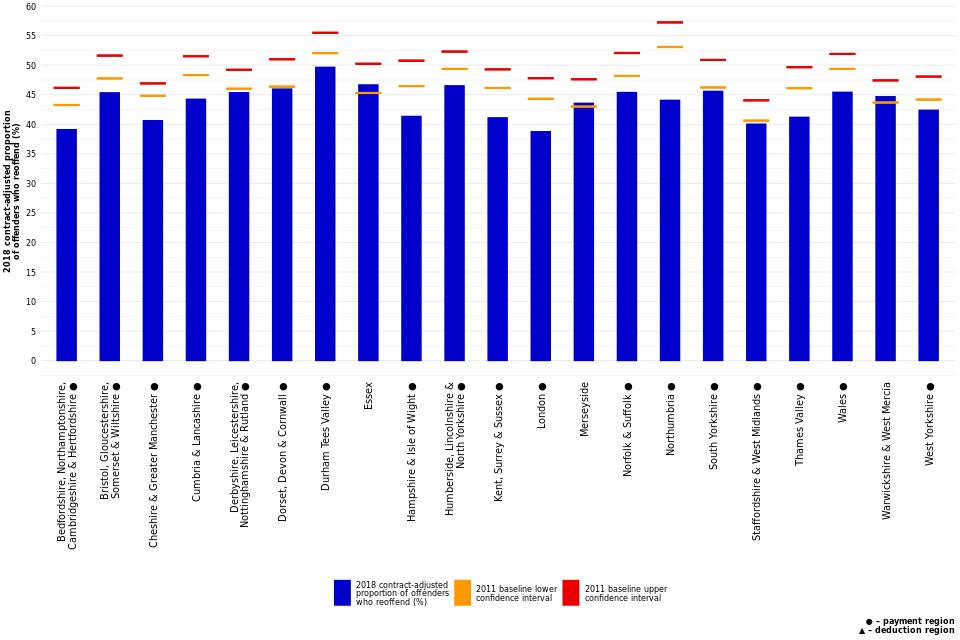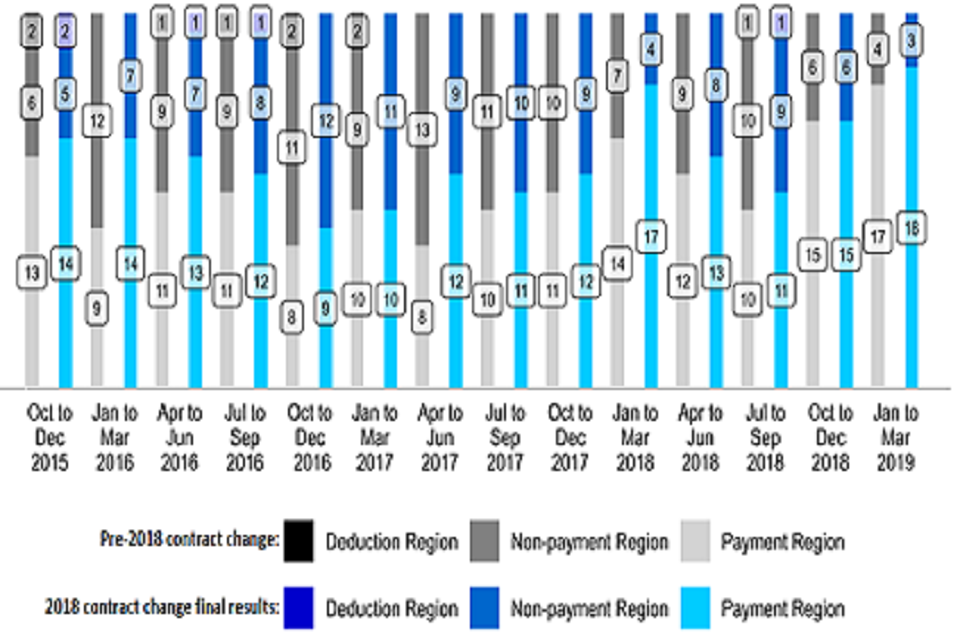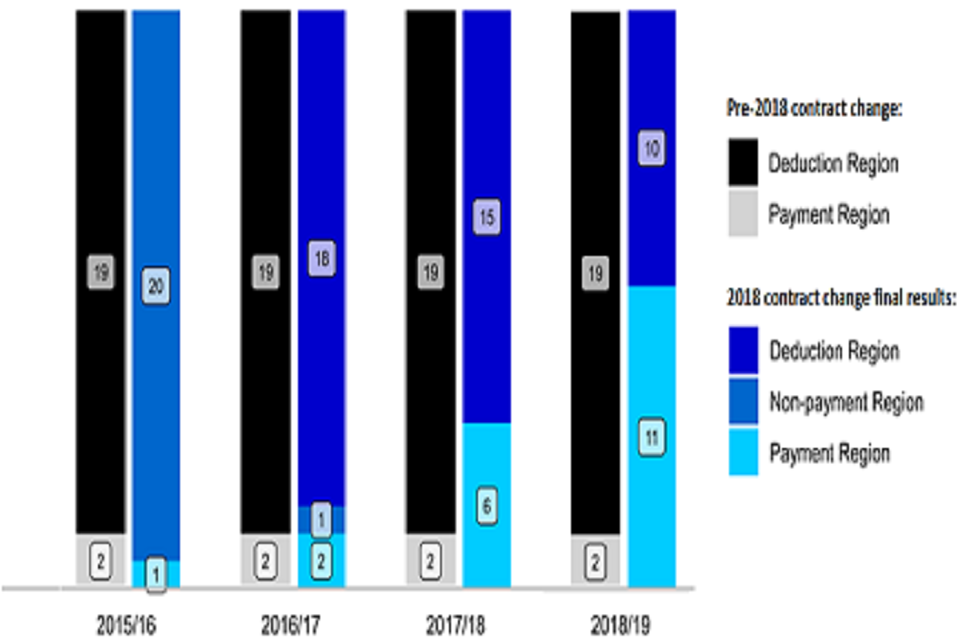Final proven reoffending statistics for Community Rehabilitation Companies and the National Probation Service
Published 27 May 2021
Applies to England and Wales
We are trialling the publication of this statistical bulletin in HTML format alongside the usual PDF version and we are seeking user feedback on the use of HTML for the publication of statistical bulletins. Please send any comments to: datausers@justice.gov.uk.
January to March 2019 and 2018/19 annual cohort
1. Main points
This publication provides the final proven reoffending results for the January to March 2019 and 2018/19 offender cohorts being managed by Community Rehabilitation Companies (CRC) under Payment by Results (PbR) arrangements.
| Eighteen CRCs achieved significant reductions in the binary rate | Eighteen CRCs in the January to March 2019 cohort will receive a payment for statistically significant reductions in the binary rate compared to the 2011 baseline. |
| None of the CRCs saw significant increases in the binary rate | None of the CRCs in the January to March 2019 cohort will receive a financial deduction for statistically significant increases in the binary rate compared to the 2011 baseline. |
| Twenty CRCs achieved significant reductions in the binary rate | Twenty CRCs in the 2018/19 annual cohort will receive a payment for statistically significant reductions in the binary rate compared to the 2011 baseline. |
| One CRC saw significant increases in the binary rate | One CRC in the 2018/19 annual cohort will receive a financial deduction for statistically significant increases in the binary rate compared to the 2011 baseline. |
| Eleven CRCs met their frequency rate targets and passed their binary hurdle | Eleven CRCs will receive a payment for meeting their frequency rate targets and achieving an improvement in the binary rate compared to the 2011 baseline (binary hurdle). |
| Ten CRCs did not meet their frequency rate targets | Ten CRCs did not meet their frequency rate targets. Deductions will, therefore, apply. |
2. Statistician’s comment
“This report covers final proven reoffending results for the January to March 2019 and 2018/19 offender cohorts being managed by CRCs under PbR arrangements. A proven reoffence is measured over a one-year follow-up period and a further six-month waiting period to allow the offence to be proven in court.[footnote 1]
Since management of offender cohorts began operating under PbR arrangements in October 2015, the number of CRCs receiving payments following statistically significant reductions in binary reoffending has ranged from nine to 18. In contrast, CRCs receiving payment deductions due to statistically significant increases in binary reoffending has ranged between zero and two over the same period.
The operational restrictions imposed on the courts in response to the COVID-19 pandemic led to a sharp decrease in the number of cases processed at the criminal courts over the period April to June 2020.[footnote 2] As the six-month waiting period for the January to March 2019 offender cohort coincided entirely with this period of reduced court activity, a substantial increase in the number of CRCs receiving payments for statistically significant reductions in binary reoffending was observed compared to the pre-COVID-19 period of July to September 2018 (i.e. 18 and 11 CRCs respectively). A notable increase in CRCs receiving payments was also reported previously for October to December 2018 – the first offender cohort to be affected by the operational restrictions (i.e. 15 CRCs compared to 11 in July to September 2018).
A substantial increase was also seen in the number of CRCs receiving a payment on the annual frequency measure of reoffending – 11 CRCs in the 2018/19 cohort compared to six and two in 2017/18 and 2016/17 respectively.
It is worth noting that the COVID-19 restrictions are likely to continue to affect subsequent offender cohorts as the measurement period for reoffending moves through the different lockdown periods of the COVID-19 pandemic.”
3. Introduction
This publication provides the final proven reoffending results for the January to March 2019 and 2018/19 offender cohorts that are being managed by CRCs under PbR arrangements. These results reflect the changes to the CRC contracts,[footnote 3] announced in 2018, which resulted in an adjustment to the binary measure and a change to the frequency baseline[footnote 4] against which CRCs are compared.
The one-year proven reoffending measures used to assess CRC performance are:
- the binary rate (proportion of offenders who reoffend); and
- the frequency rate (the average number of reoffences per reoffender)
The binary rate for each CRC is subject to an adjustment for changes in the case mix of offenders being supervised, using the Offender Group Reconviction Scale (OGRS), version 4/G,[footnote 5] to allow performance to be assessed against the baseline year of 2011.[footnote 6] This is referred to as the OGRS4/G-adjusted binary reoffending rate.
The publication also includes final results for the National Probation Service (NPS). However, please note that final results for the NPS have not changed as a result of the contract variations since they are not compared against a baseline threshold in the same way.
3.1 Contract variation
Under contract variations, the following changes have been made to the binary and frequency measures, for assessing CRC performance:
-
An additional adjustment has been made to the OGRS4/G-adjusted binary reoffending rate to account for a change in the data source in October 2015, as explained in the published technical note.[footnote 7]
-
As announced in the ‘Strengthening probation, building confidence’ consultation document,[footnote 8] the baseline year, against which CRC performance on the frequency of reoffending is compared, has now changed. All CRCs are now compared against a 2015/16 baseline, with the exception of Merseyside CRC, which has retained the 2011 baseline.
Both adjustments were applied retrospectively to all final CRC cohorts in the October 2018 bulletin.[footnote 9]
To aid the user, and in the interests of transparency, the accompanying tables include the actual binary rates before any adjustments alongside the OGRS4/G-adjusted binary rates and 2018 contract-adjusted binary rates. Further information on these changes is available in section 4.
From this point forward, the 2018 contract-adjusted binary rate will be referred to as the adjusted binary rate.
4. Final results
Final results are based on a cohort of offenders being managed by CRCs in the community under PbR arrangements following probation reforms. All offenders have been subject to the full one-year follow-up period and the additional six-month waiting period as detailed in the guide to proven reoffending statistics.[footnote 10]
Comparisons of performance between different CRCs and previous cohorts can now be made by comparing the adjusted binary rates. It remains the case, however, that comparisons cannot be made between CRCs and the NPS due to differences in the offenders being managed.
4.1 January to March 2019
Binary:
-
Payments on the binary rate will be made only for achieving statistically significant reductions in reoffending compared to the 2011 baseline reoffending rate. Deductions will be applied for statistically significant increases.
-
Eighteen of the 21 CRCs in the January to March 2019 cohort will receive a payment for achieving statistically significant reductions in the adjusted binary reoffending rate when compared to the 2011 baseline reoffending rates.
-
None of the CRCs in the January to March 2019 cohort saw a statistically significant increase in the adjusted binary reoffending rate when compared to the 2011 baseline reoffending rates.
-
The remaining three CRCs in the January to March 2019 cohort will not receive a payment or deduction on the adjusted binary reoffending rate.
Frequency:
- We cannot say which CRCs have met their frequency rate targets from a single quarterly cohort as frequency rate targets are based on annual cohorts only.
4.2 2018/19 {#}
The results for the 2018/19 cohort combine the final results from the quarterly cohorts: April to June 2018, July to September 2018, October to December 2018 and January to March 2019.
Binary:
-
Annual top-up payments are available on the binary rate for statistically significant improvements against the 2011 baseline reoffending rate. Deductions will be applied for statistically significant increases.
-
Twenty CRCs in the 2018/19 cohort will receive a payment for achieving statistically significant reductions in the adjusted binary reoffending rate when compared to the 2011 baseline reoffending rates.
-
No CRCs in the 2018/19 cohort saw a statistically significant increase in the adjusted binary reoffending rate when compared to the 2011 baseline reoffending rates.
-
One CRC in the 2018/19 cohort will not receive a payment or deduction on the adjusted binary reoffending rate.
Frequency:
-
Payments or deductions on the frequency rate are made on the annual cohort only.
-
Payments will only be made for improvements on the frequency rate if the adjusted binary rate is lower than the 2011 baseline reoffending rate (the binary hurdle).
-
Eleven CRCs in the 2018/19 cohort will receive a payment for meeting their frequency rate targets and achieving an improvement in the binary rate compared to the 2011 baseline (binary hurdle).
-
Deductions will be made for the remaining 10 CRCs in the 2018/19 cohort since they did not meet their frequency rate targets.
Figure 1: Final adjusted binary rates for the January to March 2019 Payment by Results offender cohorts, by CRC (Source: Table A1, Final proven reoffending statistics for CRCs and the NPS, January to March 2019 and the 2018/19 annual cohort, England and Wales)

Figure 1: Final adjusted binary rates for the January to March 2019 Payment by Results offender cohorts, by CRC (Source: Table A1, Final proven reoffending statistics for CRCs and the NPS, January to March 2019, England and Wales)
Figure 2: Final frequency rates for the 2018/19 Payment by Results offender cohorts, by CRC (Source: Table C4, Final proven reoffending statistics for CRCs and the NPS, January to March 2019 and the 2018/19 annual cohort, England and Wales)[footnote 11]

Figure 2: Final frequency rates for the 2018/19 Payment by Results offender cohorts, by CRC (Source: Table C4, Final proven reoffending statistics for CRCs and the NPS, January to March 2019 and the 2018/19 annual cohort, England and Wales)
Figure 3: Number of CRCs in the payment, non-payment and deduction regions in each final cohort for the binary measure (Source: Tables A1 to A14, Final proven reoffending statistics for CRCs and the NPS, January to March 2019 and the 2018/19 annual cohort, England and Wales)[footnote 12]

Figure 3: Number of CRCs in the payment, non-payment and deduction regions in each final cohort for the binary measure (Source: Tables A1 to A14, Final proven reoffending statistics for CRCs and the NPS, January to March 2019, England and Wales)
Figure 4: Number of CRCs in payment, non-payment and deduction regions for the frequency measure in each final cohort (Source: Tables C1 to C4, Final proven reoffending statistics for CRCs and the NPS, January to March 2019 and the 2018/19 annual cohort, England and Wales)[footnote 13]

Figure 4: Number of CRCs in payment, non-payment and deduction regions for the frequency measure in each final cohort (Source: Tables C1 to C4, Final proven reoffending statistics for CRCs and the NPS, January to March 2019, England and Wales)
5. Changes to the CRC contracts and implications for the final results
Adjustment to the binary result
-
The data source for offender starts in each PbR cohort changed between the procurement process for CRC contracts and the measurement of outcomes for the first PbR cohort: moving from pNOMIS (prison releases) and Form 20 (community order / suspended sentence starts) to nDelius (the case management system for probation).
-
The MoJ explored the reoffending results and found a difference in the overall binary reoffending measure resulting from the change in the data source.[footnote 14] Further analysis found this would have had a subsequent impact on the PbR mechanism, i.e. the ‘adjusted’ binary rate that incorporates OGRS4/G adjustments.
-
Consequently, the MoJ decided to make an adjustment to the OGRS4/G-adjusted binary reoffending rate for all CRCs. The adjustment is a reduction in the binary reoffending rate of 0.44 percentage points. Further information on the data source adjustment and the analysis is available in the published technical note.[footnote 15]
Adjustment to the frequency result
-
In July 2018, the MoJ launched a public consultation about the future of probation services.[footnote 16] In order to stabilise probation delivery in the immediate term, the MoJ announced an adjustment to the baseline year against which performance on the frequency of reoffending is compared. This was to better reflect the performance of providers since contracts began.
-
As a result, all CRCs are now compared against a 2015/16 frequency baseline, with the exception of Merseyside CRC, which has retained its 2011 baseline.
Both the adjustment to the frequency and binary measures were applied retrospectively and revised results for cohorts October to December 2015 through to July to September 2016 were published in October 2018.
6. Further information
Final results presented in this publication are based on a one-year proven reoffending rate. Upcoming publications of final results are listed in the following table:
| Cohort | Published in |
|---|---|
| April to June 2019 | To be confirmed |
| July to September 2019 | To be confirmed |
| October to December 2019 | October 2021 |
| January to March 2020, and 2019/20 | January 2022 |
6.1 Accompanying files
As well as this bulletin, the following products are published as part of this release:
-
A technical document providing detail on how reoffending is measured, information on how the data is collected and processed, and background information on the Transforming Rehabilitation reforms.
-
A data quality statement which outlines our policies for producing quality statistical outputs and the information provided to maintain our users’ understanding and trust.
-
A set of tables providing final proven reoffending data for the CRCs and NPS.
-
A data tool providing final proven reoffending data for the CRCs and NPS, by age group and gender.
6.2 Future publications
Our statisticians regularly review the content of publications. Development of new and improved statistical outputs is usually dependent on reallocating existing resources. As part of our continual review and prioritisation, we welcome user feedback on existing outputs including content, breadth, frequency and methodology.
6.3 Contact
Press enquiries should be directed to the Ministry of Justice press office:
Tel: 020 3334 3536
Email: newsdesk@justice.gsi.gov.uk
Other enquiries and feedback on these statistics should be directed to the Data and Evidence as a Service division of the Ministry of Justice:
Liz Whiting, Head of Reducing Reoffending and Probation Data and Statistics Team
Ministry of Justice, 7th Floor, 102 Petty France, London, SW1H 9AJ
Email: statistics.enquiries@justice.gsi.gov.uk
Next update: 29 July 2021
URL: www.gov.uk/government/collections/payment-by-results-statistics
© Crown copyright
Produced by the Ministry of Justice
Alternative formats are available on request from statistics.enquiries@justice.gsi.gov.uk
-
A full description of the measure of reoffending is provided in the guide to proven reoffending statistics, which is available at www.gov.uk/government/statistics/payment-by-results-statistics-october-2015-to-march-2020 ↩
-
First reported in Criminal Court Statistics Quarterly www.gov.uk/government/statistics/criminal-court-statistics-quarterly-april-to-june-2020 ↩
-
Voluntary ex ante transparency (VEAT) notices for all CRCs were published in July and August 2018. Please see example https://ted.europa.eu/udl?uri=TED:NOTICE:335172-2018:TEXT:EN:HTML&src=0 ↩
-
All CRCs are now compared against a 2015/16 frequency baseline, with the exception of Merseyside CRC, which has retained its 2011 baseline. ↩
-
Further information on the Offender Group Reconviction Scale 4/G can be found in the guide to proven reoffending statistics, which is available at www.gov.uk/government/statistics/payment-by-results-statistics-october-2015-to-march-2020 ↩
-
The 2011 PbR baselines and associated methodology documents are available at www.gov.uk/government/collections/transforming-rehabilitation ↩
-
www.gov.uk/government/publications/changes-to-community-rehabilitation-companies-contracts ↩
-
https://consult.justice.gov.uk/hm-prisons-and-probation/strengthening-probation-building-confidence ↩
-
www.gov.uk/government/statistics/payment-by-results-statistics-october-2015-to-december-2017 ↩
-
A full description of the measure of reoffending is provided in the guide to proven reoffending statistics, which is available at www.gov.uk/government/statistics/payment-by-results-statistics-october-2015-to-march-2020 ↩
-
In 2018 an adjustment was made to the baseline year against which performance on the frequency of reoffending is compared. As a result, all CRCs are now compared against a 2015/16 baseline, with the exception of Merseyside CRC, which has retained its 2011 baseline. ↩
-
Two contract variations associated with the binary and frequency measures of reoffending were agreed with CRCs in 2018. ↩
-
Two contract variations associated with the binary and frequency measures of reoffending were agreed with CRCs in 2018. ↩
-
www.gov.uk/government/uploads/system/uploads/attachment_data/file/658380/how-the-measure-of-reoffending-has-changed-and-the-effect-of-these-changes.pdf ↩
-
www.gov.uk/government/publications/changes-to-community-rehabilitation-companies-contracts ↩
-
https://consult.justice.gov.uk/hm-prisons-and-probation/strengthening-probation-building-confidence/ ↩
